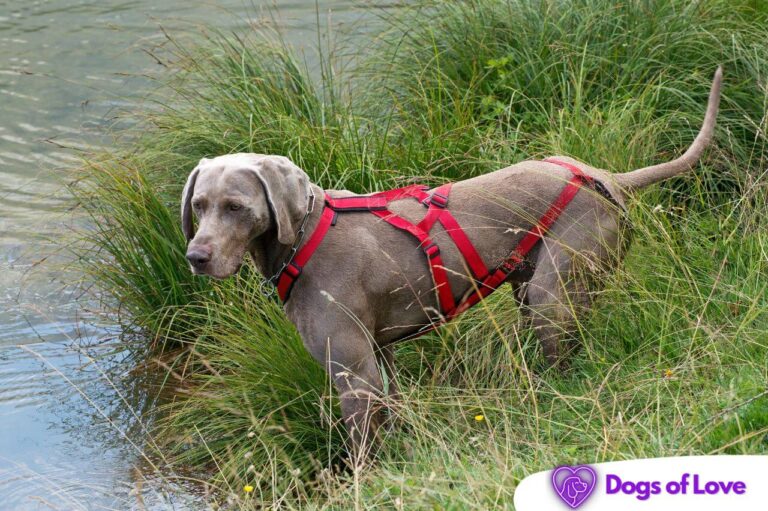The choice between a front or back harness for dogs is a decision that can significantly impact your furry companion’s comfort, safety, and overall well-being during walks and outdoor adventures.
When it comes to selecting the correct harness, pet owners often grapple with the question of whether a front or back attachment is superior.
Each option offers distinct advantages, and the decision hinges on the individual needs and behavior of your dog.
In this exploration, we’ll delve into the factors that can help you determine whether a front or back harness is the better choice for your specific canine companion, taking into account their size, walking habits, and any unique requirements to ensure a secure and enjoyable experience for both you and your pet.

What are the Dog Harnesses types, and how do they work?
Dog harnesses come in various types, each designed to serve specific purposes and cater to different dog breeds and walking styles.
One common type is the back-clip harness, which features a D-ring on the dog’s back, allowing for easy leash attachment.
Back-clip harnesses are suitable for well-behaved dogs and are often preferred for small or toy breeds.
On the other hand, front-clip harnesses have a D-ring at the chest area, which redirects a dog’s attention and helps reduce pulling during walks.
They are effective for training and controlling dogs that tend to pull or exhibit leash-reactive behavior.
Another variety is the dual-clip harness, combining both front and back attachment points, offering versatility in training and control.
Additionally, there are step-in harnesses, which are easy to put on, and head halters that provide head control, ideal for strong pullers.
The choice of harness depends on your dog’s size, temperament, and walking habits, and understanding how each type works can help you select the most suitable option for a comfortable and controlled walking experience with your pet.
What are the Cons of Front and Back Harnesses?
While front and back harnesses each have their advantages, they also come with their share of drawbacks.
Front-clip harnesses, with their leash attachment at the chest, can sometimes take dogs time to acclimate to, as the pressure on the chest area may feel unusual to them.
Some dogs may exhibit resistance or discomfort initially.
Often, the leash gets tangled between the dog’s legs.
On the other hand, back-clip harnesses may not be the best choice for dogs prone to pulling, as they do not provide the same level of control as front-clip harnesses.
Dogs with a strong tendency to pull can be challenging to manage with back-clip harnesses, making walks less enjoyable and potentially less safe.
Additionally, if not correctly fitted, both harnesses can lead to chafing or discomfort for the dog.
Therefore, selecting the correct harness for your dog should consider their behavior, comfort, and the type of walking experience you desire, balancing the potential cons with the overall benefits.
What are the Benefits of Having a Harness for Your Dog?
Having a harness for your dog offers several valuable benefits.
Firstly, harnesses distribute pressure more evenly across your dog’s body than traditional collars, reducing the risk of neck strain or injury, particularly for dogs prone to pulling.
Harnesses are also practical tools for training, as they provide better control and help manage dogs with leash-reactive behavior.
Additionally, they prevent your dog from slipping out of their collar, enhancing their safety.
Many harnesses come with multiple attachment points, allowing you to choose the best one for your dog’s behavior and needs, whether a front clip for reduced pulling or a back clip for well-behaved dogs.
Moreover, harnesses are versatile, and there are various designs to suit different activities, from walking and hiking to car safety.
Ultimately, harnesses contribute to a more comfortable and enjoyable experience for both you and your furry companion during your outdoor adventures and daily walks.
What are the Tips for Selecting the Right Harness for Your Dog?
Selecting the correct harness for your dog is a crucial decision to ensure their comfort and safety during walks.
To make an informed choice, consider your dog’s size and breed, as harnesses come in various sizes and designs to suit different needs.
Assess your dog’s behavior during walks, as dogs that tend to pull may benefit from front-clip harnesses, while well-behaved dogs can do well with back-clip harnesses.
Ensure the harness fits snugly but not too tightly, allowing your dog to move comfortably without chafing or restriction.
Look for durable, high-quality materials that can withstand wear and tear, especially if your dog is active and enjoys outdoor adventures.
Finally, please consult with your veterinarian or a professional dog trainer for guidance, as they can provide valuable insights into the most suitable harness for your pet’s specific needs and help you make the right choice for a secure and pleasant walking experience.
What are the Common Mistakes When Shopping for a Harness?
When shopping for a harness for your dog, you must be aware of common mistakes to make the right choice.
One frequent mistake is selecting the wrong size, as an ill-fitting harness can lead to discomfort and potential chafing.
To avoid this, measure your dog’s chest circumference and consult the manufacturer’s sizing guidelines. Another error is not considering your dog’s behavior and specific needs.
For example, if you have a dog that pulls on the leash, choosing a back-clip harness may not provide the necessary control.
Additionally, overlooking the quality of materials can lead to durability issues, especially if you have an active or strong dog. Not seeking professional guidance,
whether from a veterinarian or dog trainer, is another mistake.
They can offer valuable insights into the best harness type for your dog’s individual behavior and physical requirements, ensuring a more comfortable and enjoyable walking experience.
In conclusion
The choice between a front or back harness for dogs largely depends on the individual needs, behavior, and walking habits of your canine companion.
A front-clip harness, with its leash attachment at the chest, can be a practical choice for dogs that tend to pull during walks.
It redirects their attention and reduces pulling, making it easier for them to maintain control. Front-clip harnesses are also valuable for training purposes.
In contrast, back-clip harnesses are typically more comfortable for dogs that walk nicely on a leash and don’t pull.
These harnesses are easy to put on and provide a more excellent range of motion for your pet.
However, they may not be as effective at reducing pulling, so they may not be the best option for dogs with strong pulling tendencies.
The choice between front and back harnesses should be guided by your dog’s behavior and specific requirements, ensuring a comfortable and enjoyable walking experience for you and your pet.








